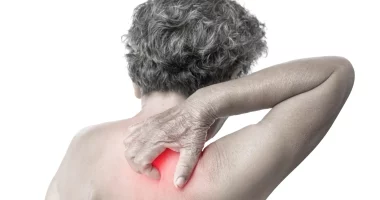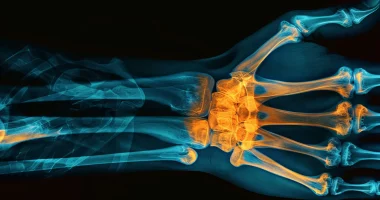Adult-onset Still’s disease (AOSD) is a rare sickness that causes inflammation in many parts of the body and usually starts when people are young adults. It shows up with symptoms like rash, fever, and joint pain.
Think of AOSD as a rare problem where adults have swelling and inflammation all over. It’s somewhat like another disease called systemic juvenile idiopathic arthritis (SJIA), which is a severe kind of arthritis that they get. The big difference is in the names: AOSD happens in adults, while SJIA pops up in individuals younger than 16. It’s named after Sir George Frederic Still, the person who first found out about it.
Symptoms
Symptoms of Adult-onset Still’s disease (AOSD) can vary a lot from person to person. Sometimes, it shows up suddenly and then goes away. Someone might have just one episode and then not have any symptoms for a long time. But for others, the symptoms stick around.
The main symptoms that about 75–95% of people with AOSD have are:
Fever
This isn’t just any fever. It’s a high fever, often above 39°C, that comes back every day and then goes away. Usually, it shows up later in the day and happens before the other symptoms.
Rashes
People with AOSD might get a rash that looks pink or salmon-colored. It’s not itchy, and it usually shows up on the trunk (the main part of the body) and on parts of the arms or legs. Sometimes, heat or rubbing the skin can make the rash appear.
Joint pain
At first, the joint pain might not be too bad, and it might only affect a few joints, like the wrists, knees, or ankles. But it can get worse and start hurting a lot, affecting many joints, even the small ones.
Other symptoms include:
- Too much muscle pain with the high temperature of the body
- Pharyngitis, which is a fancy word for a sore throat that keeps coming back when the disease flares up.
- Lymph glands swelling, like little lumps under the skin.
- An enlarged spleen, an organ in your belly that helps fight infections.
Less common symptoms can include:
- Lier sensitivity.
- Inflammation of the lining around the lungs.
- Inflammation of the heart tissue.
- Belly pain.
AOSD can happen in three main ways:
- Monophasic: This means there’s just one incident of signs that might last for weeks or months.
- Polyphasic, or intermittent: Here, a person might have more than one episode of symptoms. They might not have any symptoms for weeks or even years between incidents, and when the symptoms come back, they’re usually not as bad as before.
- Chronic: In this form, the symptoms stick around for a long time without going away.
Causes and Risk Factors
Scientists aren’t exactly sure why Adult-onset Still’s disease (AOSD) happens, so they call it idiopathic, which means they don’t know the cause yet. But they think it might be a mix of genes and an infection that starts it off.
Here’s what they’ve found out so far:
Genes
Some genes that make proteins to control inflammation might have something to do with AOSD. For example, there are genes called TNFRSF1A and IL1A that make proteins like tumor necrosis factor receptor 1 and interleukin-1 alpha. These proteins are usually more active in people with AOSD.
Infections
Certain germs might kick-off or make AOSD symptoms worse. These could be bacteria or viruses like Yersinia enterocolitica, Mycoplasma pneumoniae, or cytomegalovirus (CMV). So, AOSD might happen when someone’s body reacts to these infections, especially if they’re already kind of likely to get it because of their genes.
Usually, there’s no clear reason why someone gets AOSD, and it doesn’t usually run in families. People usually start showing symptoms before they’re 40, and it seems to affect women a bit more than men.
Diagnosis
Diagnosing Adult-onset Still’s disease (AOSD) isn’t easy because there’s no one test that can say for sure if someone has it or not. Doctors usually figure it out by:
- Clinical examination and history: The doctor will ask lots of questions about the person’s symptoms and do a thorough check-up.
- Characteristic findings: They look for specific signs that are common in AOSD.
- Ruling out other conditions: Since AOSD symptoms can look like other diseases, doctors need to make sure it’s not something else.
- Imaging and blood tests: These tests help to confirm the diagnosis and see if there’s any damage inside the body. Doctors might do:
- X-rays or MRI scans to check for joint or bone problems.
- Ultrasound to see if the spleen or liver is swollen.
- Echocardiogram to check if there’s inflammation around the heart.
- Blood tests: Doctors check different things in the blood, like:
- Inflammatory markers such as erythrocyte sedimentation rate (ESR) and C-reactive protein (CRP).
- Complete blood count (CBC) to see if there are enough blood cells.
- Serum ferritin levels, which frequently higher than normal in individuals with AOSD.
- Levels of liver enzyme.
- Antinuclear antibody (ANA) and Rheumatoid factor (RF) to rule out other diseases like rheumatoid arthritis.
There are different sets of rules (criteria) for diagnosing AOSD, but the Yamaguchi criteria are used most often because they’re very good at catching it. To get a diagnosis, someone needs to meet at least five of the criteria, along with at least two of the big ones:
Major criteria:
- Having a high temperature of 39°C for at least 7 days
- Arthritis or joint pain for at least 14 days
- A rash that’s pink or salmon-colored and doesn’t itch
- A high white blood cell count.
Minor criteria:
- Sore throat
- Swelling of lymph glands
- Enlarged spleen or liver
- Unusual liver test results
- Negative results for ANA and RF
Treatment
Treatment for Adult-onset Still’s disease (AOSD) focuses on several goals: decreasing inflammation, managing symptoms, and preventing damage to organs. Doctors typically recommend different medications to achieve these aims.
They might suggest:
- Nonsteroidal anti-inflammatory drugs (NSAIDs), which can be bought over the counter or prescribed by a doctor, help reduce inflammation and ease pain.
- Corticosteroids like prednisone, which are strong anti-inflammatory drugs that can quickly bring down inflammation and relieve symptoms.
- Disease-modifying drugs (DMARDs) like methotrexate, are often used along with corticosteroids to control inflammation and minimize side effects.
Biologics, which are a newer type of medication that targets specific parts of the immune system. These include:
- Interleukin-1 (IL-1) inhibitors like canakinumab (Ilaris)
- IL-6 inhibitors like tocilizumab (Actemra)
- Tumor necrosis factor-alpha inhibitors like infliximab (Remicade)
Even after the symptoms improve, a person might still be required to take these medications. This ongoing treatment helps to keep inflammation in check and stop further damage to bones, cartilage, and organs.
Summary
Adult-onset Still’s disease is an infrequent autoimmune inflammatory condition that typically shows up in adulthood. It’s marked by symptoms like joint pain, fever, and salmon-pink rashes. This disease is quite similar to systemic juvenile idiopathic arthritis, which affects children.
AOSD can vary from person to person. Some might only have one incident of symptoms, while others might deal with ongoing issues. Right now, doctors aren’t sure what causes it, and there’s no one-size-fits-all treatment plan. But treatments, self-care strategies, and lifestyle changes can all help manage the symptoms.
It’s important for someone with AOSD to work closely with their doctor to figure out the best way to treat and handle their symptoms.









